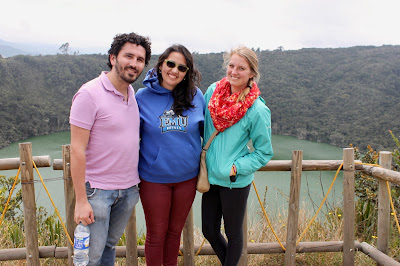Last weekend I had to privilege of going to Laguna de Guatavita where the legend of El Dorado began. This lake was and still is sacred to the Muisca people (an indigenous people in Colombia). It is said that many years ago, as part of a religious ceremony, the Muisca tribal leader would cover himself in gold dust. Then he would get on a raft along with the tribal priests and gifts of gold. They would push out into the middle of the lake. They would offer their gifts to the gods by throwing them into the lake. Then the chief himself would jump into the lake allowing the water to clean off all the gold dust.
Years later, word got out that this lake was filled with gold. The Spaniards arrived and attempted to drain the lake. This was not successful, but they did manage to remove some pieces of gold. When other Europeans heard that Spain found gold in the Laguna de Guatavita, the rumor of this Empire called El Dorado came about. It is important to note that the Muisca people did not see gold the same way as the Europeans in the sense of wealth but rather it was something that connected them to the spirits and gods. Other Europeans attempted to drain the lake, and although they never succeeded, the lake has lost its depth. It once reached the depth of about 70 meters. Today the lake is around 40 meters deep.
Europeans removed most of the gold from Laguna de Guatavita. However, since the Muisca performed the gold gift-giving ritual for hundreds of years, it is possible there is still gold inbedded in some of the clay and rocks.
The origin of Laguna de Guatavita is a mystery. There have been several theories as to how it was created. Some believe that it was once a volcano. Others believe it was formed by a meteorite impact or from a limestone sinkhole. The most recent findings lead to a possible salt sinkhole as the birth of the lake. The land surrounding the lake is salty, and there are many salt mines and caves found in the area.
Here are some photos:
 |
| My Friend and Spanish Teacher Diana |
 |
| The Climb |
 |
| The View |
 |
| Laguna de Guatavita |
 |
| My Adventure Companions: Falipe and Diana |
 |
Another one...
|
 |
| And the journey continues |
 |
This golden artifact was found in the lake of Guatavita (photos above). It is a replicant of what the of the tribal leader and the priests on a raft would have looked like going out in the middle of the lake to make an offering. This artifact is worth more than the whole "Gold Museum" (where it is being displayed) because it tells us a lot about history of the people and how this ritual of offering gold in the middle of the lake would have looked like.
|
Please note that the information I got was from our tour guide. Also Diana and Falipe filled me in on the information that I could not understand or missed (the tour was in Spanish). I did some extra research but could not find much more than what the tour guide said. Therefore, if I missed or messed up on any information or history, my apologies, but please feel free to correct me by leaving a message below.





















